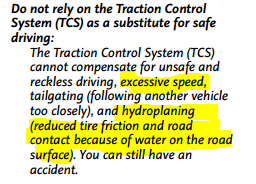I have 2014 CX-5 Grand Touring FWD with about 26k miles. All services have been handled by a Mazda Dealer.
Tonight, while returning from Antioch CA to San Jose CA via I-680 I had a very scary situation that came out of the blue in the hills region.
It had been raining heavily and traffic was fairly heavy. For most of the time I had Speed Control engaged at 60 mph but based on the surrounding traffic I would disengage Speed Control and use the accelerator to slow down or speed up. I had noticed that on occasion there had been a feeling of momentary loss of traction. This happened mainly when changing lanes or transiting a deeper puddle.
I had been driving for about 5 minute using the accelerator to control speed and as I was at just about 60mph (the setting on the Speed Control) I started to change lanes and at about the same time engaged the Speed Control.
THIS IS WHERE THE SCARY PART STARTS.(flame)
The car immediately decelerated and at the same time the Tach reading went up to about 6k. I tried to recover using the accelerator but this only made the situation worse because the sped would increase and then decrease. I turned on my Emergency Flashers and managed to make my way over to the curb lane without crashing in spite of the fact that most of the traffic was at about 50~60mph. Once I got to the curb lane I stopped. Then I slowly accelerated up to about 40mph in the curb lane and merged into the right-hand lane once I was confident that I had regained speed control. From this point I did not re-engage Speed Control and was able to drive at about 60mph so I could return home.
I have NEVER had this happen before. It was raining heavily and there was water on the road but I didn't see any spots where it was running across the road like a river.
Let me say, THIS IS NOT ACCEPTABLE and I hesitate to think what might have happened if I had been an inexperienced driver in this situation.
I hope I am not alone in experiencing this and Mazda had developed a software fix for the problem.
I firmly believe this was caused by a conflict between the Traction Control, Speed Control, and feed back coming from a wet surface.
Tonight, while returning from Antioch CA to San Jose CA via I-680 I had a very scary situation that came out of the blue in the hills region.
It had been raining heavily and traffic was fairly heavy. For most of the time I had Speed Control engaged at 60 mph but based on the surrounding traffic I would disengage Speed Control and use the accelerator to slow down or speed up. I had noticed that on occasion there had been a feeling of momentary loss of traction. This happened mainly when changing lanes or transiting a deeper puddle.
I had been driving for about 5 minute using the accelerator to control speed and as I was at just about 60mph (the setting on the Speed Control) I started to change lanes and at about the same time engaged the Speed Control.
THIS IS WHERE THE SCARY PART STARTS.(flame)
The car immediately decelerated and at the same time the Tach reading went up to about 6k. I tried to recover using the accelerator but this only made the situation worse because the sped would increase and then decrease. I turned on my Emergency Flashers and managed to make my way over to the curb lane without crashing in spite of the fact that most of the traffic was at about 50~60mph. Once I got to the curb lane I stopped. Then I slowly accelerated up to about 40mph in the curb lane and merged into the right-hand lane once I was confident that I had regained speed control. From this point I did not re-engage Speed Control and was able to drive at about 60mph so I could return home.
I have NEVER had this happen before. It was raining heavily and there was water on the road but I didn't see any spots where it was running across the road like a river.
Let me say, THIS IS NOT ACCEPTABLE and I hesitate to think what might have happened if I had been an inexperienced driver in this situation.
I hope I am not alone in experiencing this and Mazda had developed a software fix for the problem.
I firmly believe this was caused by a conflict between the Traction Control, Speed Control, and feed back coming from a wet surface.


